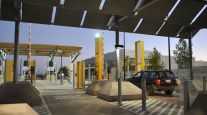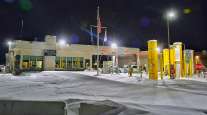Technology Can Put Truckers in the Fast Lane When Crossing Canadian and Mexican Borders
This story appears in the Nov. 22 print edition of Transport Topics.
Safety and security remain a top concern for fleets crossing both the northern and southern borders, and motor carriers — including Celadon Group Inc. and Trimac Transportation Services Inc., Calgary, Alberta — are turning to the latest technology, electronic transmissions and voluntary government programs to streamline crossings and protect their freight.
“The way that Canada and U.S. Customs are going, this will be a paperless industry, and everything will be done electronically,” said Brad Wood, customs compliance coordinator for truckload carrier Celadon.
The Canadian Border Services Agency moved one step closer to that end late last month when it launched the Advance Commercial Information eManifest program for motor carriers. The program requires the electronic transmission of advance cargo and conveyance information from carriers and is voluntary until 2012.
ACI was created to increase security in a post-9/11 world, but CBSA eManifest Director Jason Proceviat said the automation should accelerate processing times at the border. U.S. Customs and Border Protection launched a similar program, Automated Commercial Environment, in the United States in 2007, so motor carriers already are familiar with the process.
Trimac, a bulk carrier with headquarters in Calgary, Alberta, adopted ACI early.
“This will streamline moves into Canada as ACE has streamlined moves into the U.S.,” said Cindy Hancock, a regulatory compliance supervisor for Trimac, which operates in Canada, the United States and Mexico. The U.S. headquarters of the company, which ranks No. 40 on the Transport Topics 100 list of the largest U.S. and Canadian for-hire carriers, is in Houston.
Brian Culp, director of research and development for Celadon, said the Indianapolis-based fleet, which ranks No. 42 on the for-hire TT 100, works closely with CBSA to be an early adopter of ACI, as well.
“We’re basically modeling this programming off of what we already have in place with ACE,” Culp said.
To transmit data to CBSA, carriers can develop an in-house transmission protocol, contract with service providers or use the Web-based portal CBSA plans to release in early 2011.
When carriers provide their information to CBSA electronically, they receive a conveyance reference number and bar code that they present at the border to link to their data into CBSA’s system. The agency plans to introduce transponder technology eventually and would like to harmonize it with the transponder technology the United States uses, Proceviat said.
Richard Case, general manager of transborder and expedited services for Toronto-based Vitran Corp., No. 35 on the for-hire TT 100, said the truckload and LTL carrier intends to adopt ACI early, and its internal IT department has been updating its programming.
“We have spent literally thousands of dollars preparing,” Case said. “It has been weeks of man-hours to be able to transmit the data to Customs’ standards.”
Monica Truelsch, director of marketing for TMW Systems Inc., Cleveland, said that the software provider has been working with carriers on ACI solutions.
She said, “Carriers that have a core transportation-management software system that has driver information, truck details and load and commodity information, are a leg up over carriers that are using some systems that don’t use an [electronic data interface] yet.”
David Zavitz works with TMW and CBSA to coordinate ACI implementation for K.A.M. Trucking Inc. in Wainfleet, Ontario. He said he believes generating an eManifest will be easy because he already uses TMW’s dispatching software.
“For us, it’s the natural option, but there are a number of companies providing ACI eManifest EDI solutions,” Zavitz said.
To cut down on back-office ACI labor for carriers, PeopleNet has been implementing its geofencing and automated messaging platforms to enable alerts and electronic-form delivery to the border before a truck arrives. With the technology, fleets can create a virtual perimeter in a geographic area — the geofence — at their particular crossings.
“When trucks trip geofences as they travel down the road, it automatically sends off e-mail notification and [electronic] document delivery to a predefined e-mail address,” said Brian McLaughlin, PeopleNet’s chief operating officer.
Other TMW competitors told Transport Topics that they have not yet developed software systems that they can use with ACI.
In addition to costs to update computer programming, Vitran’s Case said, there will be additional administrative costs to prepare each entry.
“It is administratively onerous but, on the same token, hopefully, it does streamline things at the border, and the number of border delays are reduced,” Case said.
Culp said he expects to “experience hiccups along the way with testing,” but Celadon hopes to get in on “the front end and have 12 to 15 months of trial and error to work through those issues.”
ACI is one of several programs in Canada and the United States that are working to increase security, border officials said.
In addition to adopting ACI early, Celadon has embraced the Customs-Trade Partnership Against Terrorism program — a voluntary initiative in which carriers agree to take extra security precautions.
“In return, Customs and Border Protection provides some incentives,” said Bradd Skinner, director of the C-TPAT program. Those incentives include fewer exams for C-TPAT partners and access to “Free and Secure Trade” lanes. In September, the program surpassed 10,000 members.
Several carriers told Transport Topics they are satisfied with the program. Ron Joseph, president of TransX USA, a unit of TransX Group of Companies, based in Winnipeg, Manitoba, and No. 48 on the for-hire TT 100 list, said C-TPAT certification helps keep his staff and shippers aware of security threats. Culp said Celadon has seen its wait times at the border and the number of X-rays and secondary inspections reduced.
However, Jennifer Fox, vice president of customs and compliance for the Ontario Trucking Association and vice president for customs at the Canadian Trucking Alliance, said some in the industry feel they are not getting as many benefits from C-TPAT, the Free and Secure Trade program and other trusted trader programs as they had hoped.
“Part of the problem is that when there is congestion at the border, it doesn’t matter if there is a FAST lane or not,” Fox said.
FAST (Free and Secure Trade) lanes are dedicated lanes at 55 U.S. border crossings that allow for expedited processing for carriers that have completed background checks and take part in C-TPAT. To be eligible to use a FAST lane, every link in the supply chain for a particular load must participate in the C-TPAT program.
Trimac joined in C-TPAT and FAST.
“It has made a difference, but it hasn’t been the difference we are looking for,” said Carlos Berriochoa, Trimac’s manager of international operations. “We still have to get in line with the rest of the trucks for X-rays and inspections with DOT.”
What’s more, OTA’s Fox said, the carrier’s benefits are completely contingent on whether or not the importers or the shippers participate in the program.
“It has become more of a marketing scheme,” she said.
While several government initiatives are intended to speed border crossings, carriers are worried a new federal requirement that motor carriers and exporters stipulate on electronic manifests the amount of residual product left inside trailers and tankers after making deliveries in Canada and Mexico could cost them both time and money.
“Whether it is a dump truck with a few wood chips in the bottom of it or a tank truck with some milk in it, carriers would have to file an eManifest to tell CBP what the exact quantity is,” Fox said.
The requirement, yet to be enforced, originally was set to become effective in August 2009. CBP is working on a timeline for full enforcement, said Jenny Burke, a CBP spokeswoman.
Fox said that, in the past, residual quantity entered the United States as part of the instrument of international traffic.
“In a trailer, you can have a rack, load bars or anything that remains in the trailer to secure the load, that goes back and forth, but no one really owns it,” Fox said. “There is a bond on file with customs to say they can go back and forth across the border.”
Trailers with residual product “are not merely empty instruments of international trade,” Burke said.
“The lack of compliance with customs laws is not only a security risk to the U.S.,” she said, “but a potential risk to the health and safety of CBP officers unaware of the volume or contents of the containers they are encountering.”
Ron Martin, president of hazardous materials hauler Bridgeland Terminals Ltd., Elmira, Ontario, said the requirement will add brokerage costs and potentially cause time delays at the border. An alternative to filing an eManifest would be washing the trailer before bringing it into the United States, which Martin said would cost about $250 per wash and $60 an hour in driver downtime.
Filing an entry will require a customs broker. Berriochoa said the actual entry would take about 20 minutes.
“It has been a fight because of the difficulties and the time and the cost that it would bring to the people itself of having to do this,” he said.
Fox pointed out another issue.
“The bigger question is, who owns that residue?” she said. “Is it the shipper? Is it the carrier? Who is going to pay for this?”
American Trucking Associations has created a “hybrid solution” that would create a safe harbor for residue returning to the United States in quantities less than 3% of the container capacity, said Richard Moskowitz, an ATA vice president and regulatory affairs counsel. Carriers would identify the residue that is returning to the United States in an abbreviated manifest but would not estimate the value, which, he said, is nearly impossible for the carrier to do.
Many containers return to the United States empty and would be subject to the regulation. For example, Berriochoa said about 90% of Trimac’s tank trailers return empty from Mexico.
Joseph said southbound loads to the United States from Canada are becoming harder to find because of the growing strength of the Canadian dollar.
As fleets look to increase their efficiency, carriers told TT they would like to have the ability to easily conduct in-transit moves — cutting through either the United States or Canada to make a delivery.
Margaret Irwin, director of customs, immigration and cross-border operations for ATA, said most fleets avoid in-transit moves because of the cumbersome paperwork it requires.
“We’re looking forward to the time when Canada can collect information and when necessary pass it back to the United States,” she said.
Joseph said the ability to cut through Canada would result in “significant” savings.
“Obviously, you can save miles in terms of operating when you’re passing through Canada if you’re going north instead of going all the way around the lakes,” he said.
Proceviat said there are Canadian carriers interested in being part of an in-transit pilot project, but CBSA is “in a holding pattern until U.S. Customs Border Services comes onboard.”
Irwin said a pilot program should be launching soon, but she didn’t know when it would start. CBP did not respond to inquiries on the program.



